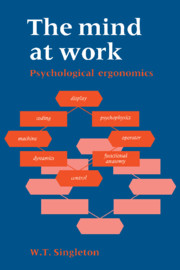4 - PERFORMANCE AND JOB DESIGN
Published online by Cambridge University Press: 22 September 2009
Summary
Concepts
One of the fundamental attributes of human behaviour is that it changes continuously along the time dimension. This fact is neglected by many experimental psychologists who are attempting to describe the behaviour of the human operator, the average man, the laboratory subject (actually labelled ‘S’ in some journals) or even the human organism (labelled ‘O’). This is only defensible provided that it is recognised that whatever properties are adduced they relate to a static abstraction. The properties of this abstraction are described in Chapter 5 but as a preliminary to such studies the set of concepts which express what is known about dynamic behaviour are needed.
The constructive changes in time are generally put into the category of learning already described in Chapter 2. The analogous negative changes which occur in parallel are described as fatigue (in the short term) and ageing (in the long term). Ageing is also dealt with in Chapter 2.
There are several concepts which centre on the facility to change level of activity either voluntarily or involuntarily. This is described as arousal. Within arousal studies two sets of phenomena have been identified and investigated in great detail, particularly over the past forty years. These are stress and vigilance. Stress was adopted as a popular behavioural research topic because it seemed to have possibilities of easier measurement than fatigue which had its heyday from 1920 to 1950.
- Type
- Chapter
- Information
- The Mind at Work , pp. 159 - 193Publisher: Cambridge University PressPrint publication year: 1989



